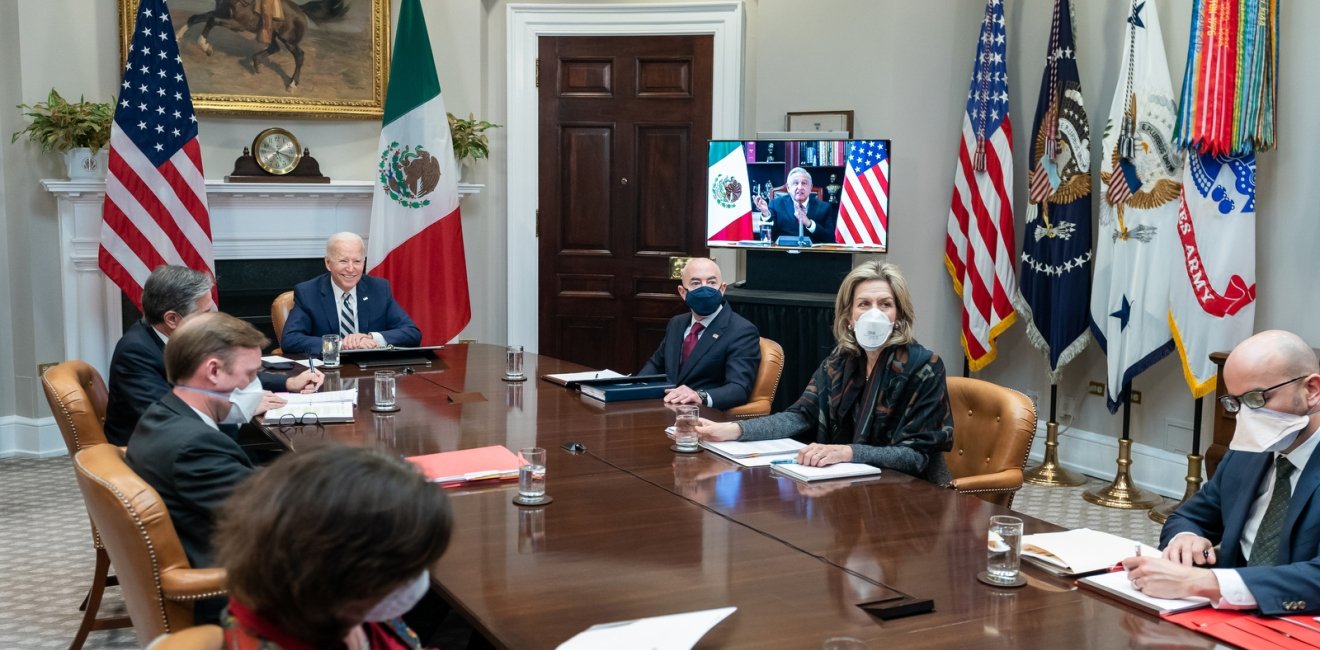There were high expectations for the U.S.-Mexico relationship in January 2021 when President Joe Biden took office. After four tumultuous years during the Presidency of Donald J. Trump, experts expected the bilateral relationship to return to a more stable basis. Although the idiosyncratic approach adopted by the Trump Administration, using threats of tariffs and border closures to secure Mexican cooperation, had been managed admirably by Mexican foreign secretary, Marcelo Ebrard, the relationship seemed to be balanced permanently on the knife's edge, with crisis looming just over the horizon. With Biden’s inauguration, there was hope that the relationship would once again be defined by the institutions of diplomacy, economic statecraft, and interagency communication and collaboration.
At the same time, however, some analysts feared that personal tensions between Biden and Mexican President Andres Manuel Lopez Obrador (AMLO) might derail a positive beginning to the relationship. AMLO’s refusal to acknowledge Biden’s victory until the Electoral College certification vote was viewed by many as both petty and unnecessary, and pandering to false claims of electoral fraud. The Biden Administration, however, decided to ignore the personal slight and instead focus on building a more solid institutional framework for the bilateral relationship during the following 12 months.
As we pass the one-year anniversary of Biden’s inauguration, it's impressive to see how much of that institutional framework has been constructed and strengthened. From the economy to security and migration, cooperation between the U.S. and Mexican governments has advanced, despite the ongoing tensions over issues such as labor rights, the energy sector, climate change, and investor protections. This is not to say that the results have been to everyone’s liking. In fact, the restraint shown by the U.S. government over the past year on the issues of energy and democratic backsliding, as well as the continued cooperation on stemming Central American migration, have drawn complaints from groups on both sides of the border, who were hoping for a more aggressive approach. However, it is becoming clear that the institutional approach has been successful in creating a set of constraints, incentives, and opportunities for long-term collaboration between the two countries that will extend far beyond both the Biden presidency and the issues that dominate the relationship today.
The Economy
On the economic front, 2021 began with several problematical issues between the Mexican and U.S. governments. Ongoing uncertainty in the energy sector, the cancellation of an American-owned brewery project in Mexicali, and the number of looming trade disputes, from tomatoes to electric vehicles, seemed to portend a fraught relationship between the two countries.
Throughout the year, however, the Biden Administration worked with Mexican counterparts to reconstruct the institutional framework for that economic relationship. The one-year anniversary of the United States-Mexico-Canada-Agreement (USMCA) and the November North American Leaders’ Summit (NALS), the first in five years, grabbed headlines on both sides of the border. However, a much more significant achievement has been the rebirth of the High-Level Economic Dialogue (HLED) during the first year of the Biden Administration. The HLED is significant because it creates a framework and a channel for exploring new directions in the bilateral economic relationship, while at the same time, allowing for discussion of potentially thorny issues. This approach to addressing the economic opportunities and challenges in the bilateral relationship was a significant element during the Peña Nieto and Obama Administrations but was completely ignored during Trump's years in office. This kind of institutional approach is particularly important given the scale of the bilateral economic relationship. Although final statistics are not yet available, it looks as though Mexico will remain the number one trading partner of the United States in 2021, with a total of more than $650 billion in two-way trade.
Over the past 12 months, the combination of the USMCA, the HLED, and the global supply chain crisis has resulted in continuous investment in Mexico, as producers have sought to re-shore and nearshore their manufacturing facilities. AMLO recognized as much in his comments at the NALS meeting in November 2021 where he uncharacteristically spoke at length about supply chains, competition with China, and the need for greater North American economic cooperation. The institutional framework of the economic relationship has provided investors with greater certainty, at a time of economic dislocation and less-friendly government policies in Mexico.
A January 2022 meeting between the Mexican Under-Secretary of the Economy, Luz Maria de la Mora, and the Deputy U.S. Trade Representative, Jayme White, served to highlight the benefits of an institutional approach. In the meeting, held on the eve of a meeting of the deputy trade representatives of the USMCA countries, White emphasized the importance of free and fair competition in the energy sector with his Mexican counterpart. This thorny issue, so often neglected in public discourse on the bilateral economic relationship, is seen as being critically important to the future prosperity of North America, as well as to the challenge of mitigating climate change. A visit to Mexico by U.S. Energy Secretary, Jennifer Granholm, brings more pressure on the AMLO Administration on the issue of electricity sector reform.
Security and migration
Just two weeks into 2021, Mexico ignited controversy in the bilateral security relationship by exonerating former Defense Minister, Salvador Cienfuegos Zepeda following his arrest on U.S. territory for drug trafficking. His extradition materialized only after the Mexican government threatened to terminate cooperation with U.S. forces in the fight against narcotrafficking – a threat that cast a pall on bilateral security cooperation. A few months later, in August, the Mexican government sued several major U.S. gun manufacturers, citing negligent business practices that have facilitated gun trafficking across the border and into Mexico. The lawsuit alleges that these practices have allowed the gun manufacturers to reap substantial profits, but at Mexico’s expense, resulting in costs of nearly 70,000 gun-related deaths in Mexico throughout the past two years. However, despite the rocky start to bilateral security and migration collaboration in 2021, real progress has been made in institutionalizing cooperation under the Biden and AMLO administrations.
The reopening of the US-Mexico land border after 19 months of closure due to the pandemic marks a significant turning point in the bilateral relationship under the Biden and López Obrador presidencies. However, two policy initiatives that came in the weeks both preceding and following the border’s reopening are far more indicative of the direction currently being taken by the bilateral relationship. The first of these was the launch of a new security framework, U.S.-Mexico Bicentennial Framework for Security, Public Health, and Safe Communities; the second is a mechanism for US-Mexico cooperation to address the causes of migration from southeastern Mexico and Central America, Sembrando Oportunidades.
In October 2021, senior government officials from the US and Mexico convened to discuss economic and security priorities, a conversation which paved the way for the October High-Level Security Dialogue and subsequent launch of the U.S.-Mexico Bicentennial Framework for Security, Public Health, and Safe Communities, an update to the much-maligned Mérida Initiative. While the specifics and the outcome of the Bicentennial Framework are still to be determined, the basic language of the framework marks a departure from the strategy of the Mérida Initiative, listing “protecting our people” first and “pursuing criminal networks” last – a complete switch from Mérida.
On the migration front, there has been both continuity and change. For many, Biden offered the hope of a change in migration policy at the southwest border, a shift away from the draconian policies that characterized the Trump Administration’s approach. However, two key policies from the Trump Administration remain in place: Title 42 and the Migrant Protection Protocols (also known as Remain in Mexico). The Biden Administration has continued to utilize the pandemic as justification for the denial of entry to the U.S. and the expulsion of asylum seekers at the border via Title 42, despite urging from public health experts that the policy is “scientifically baseless and politically motivated” and that it hinders the US from fulfilling its obligation to protect asylum seekers. The Biden Administration did, however, exempt minors from expulsion under Title 42.
Court challenges have made the termination of another signature Trump migration policy, MPP, difficult. Though, since the earliest days of the presidential campaign and presidency, the Biden Administration has announced plans to terminate MPP, U.S. courts have enforced the policy, forcing the eventual restart of the program in December 2021. Since then, over 200 migrants have been returned to Mexico, numbers that are likely to grow as the program expands to additional border cities in 2022. Efforts have been taken to make the policy more humane, including better access to legal counsel, but the Biden Administration is still taking steps to terminate the program, just recently filing a petition with the Supreme Court to terminate MPP.
There has been an increase in official, high-level engagement from both countries, including an increased number of visits and meetings of senior officials from DHS, the NSC, and the State Department. Perhaps most notable are the handful of direct interactions between Vice President Harris and President López Obrador, with both governments affirming their mutual commitment to addressing the roots causes of migration.
All of this suggests that we are seeing both a greater socialization of the relationship and a greater level of institutionalization between the two countries, such as the work being done on migration, specifically under Sembrando Oportunidades. Collaboration between the Biden and AMLO administrations has primarily focused on addressing the root causes of irregular migration, with a specific focus on the Northern Triangle of Central America and southeastern Mexico. The two governments have put forth Sembrando Oportunidades, a program to be led by USAID and AMEXCID (Mexican Agency for International Development and Cooperation) to foster skill development to ensure long-term employment in the Northern Triangle, with the goal of reducing irregular migration flows from this region. Under this framework, USAID will assist with the expansion of market access for regional farmers, while also piloting conditional cash transfers. AMEXCID will support communities through the continuation and expansion of Sembrando Vida[1], one of AMLO’s signature welfare programs that aims to address deforestation and poverty through the planting of 3 billion trees which in turn would create an estimated 1.2 million jobs across the region.
In the short term, however, the AMLO Administration’s bilateral cooperation on Biden’s migration strategy has taken the form of massive deportation of Central Americans. In the first 11 months of 2021, Mexico detained over a quarter of a million migrants (a 206% increase from 2020), 192,000 of whom were Central Americans, the vast majority from Honduras and Guatemala. During that same period, Mexico deported over 80,000 migrants. Under the president’s orders, Mexico’s migration management strategy has become increasingly militarized. The Mexican National Guard, despite a lack of relevant training, has taken a significant role in migration management, but this lack of training, coupled with the absence of migrant protections in Mexico, has resulted in unsafe conditions, rife with human rights abuses.
At the border in towns like Ciudad Juárez, and in cities of transit, like Tapachula, coyotes, cartel members, and even National Guardsmen prey on vulnerable migrants and asylum seekers. Dispatches from this summer at both borders, the US-Mexico and Mexico-Guatemala border, highlighted the conditions migrants face at the hands of migration authorities. Images of the Mexican National Guard in a phalanx, shooting tear gas and rubber bullets to stop a massive crowd of Central American migrants and pictures of CBP agents at the US-Mexico border, on horseback, whipping Haitian migrants crossing the river from Ciudad Acuña, Mexico to Del Rio, Texas showed the reality of life for migrants and asylum seekers trying to cross the border.
The path ahead
After one year, the Biden and AMLO administrations still face several challenges as they navigate the bilateral relationship. Energy, climate, investor relations, and humane treatment for migrants all loom as contentious issues that will test the largely friendly state of cross-border relations. These are all areas that divide opinion in both countries, but the Biden team has worked with its counterparts in Mexico to craft an institutional rebuild that binds the two governments more closely together and establishes predictable patterns of interaction and spaces where divisive issues can be discussed, and mutually acceptable compromises negotiated.
Over the next three years leading up to the elections in 2024 in both countries, we should expect this approach to continue. Its success will depend, in part, on the willingness of AMLO, a politician famed for shunning institutions, to continue this mode of interaction. The U.S. mid-term elections this year, as well as the prospect of a referendum in Mexico on the AMLO presidency, will play a role in determining the priorities and attitudes of both governments. For the time being, however, it seems that the relationship will be shaped by institutions as much as by personalities.

[1] This project has its origins at the White House’s virtual climate change summit in the spring of 2021 where AMLO proposed the expansion of Sembrando Vida to include Northern Triangle countries and suggested that the Biden Administration finance the expansion of the program, while also offering program participants the opportunity to obtain residency in the US - suggestions that received substantial criticism, especially given the lack of clarity on the efficacy of Sembrando Vida, namely allegations that the program has actually increased rates of deforestation, encouraging the clearing out of forests to clear space for the planting of new trees.
Authors



Mexico Institute
The Mexico Institute seeks to improve understanding, communication, and cooperation between Mexico and the United States by promoting original research, encouraging public discussion, and proposing policy options for enhancing the bilateral relationship. A binational Advisory Board, chaired by Luis Téllez and Earl Anthony Wayne, oversees the work of the Mexico Institute. Read more

Explore More
Browse Insights & Analysis
Promoting Convergence in US-Brazil Relations

360° View of How Southeast Asia Can Attract More FDI in Chips and AI

Israel Escalates Attacks in Gaza: What’s Next?

